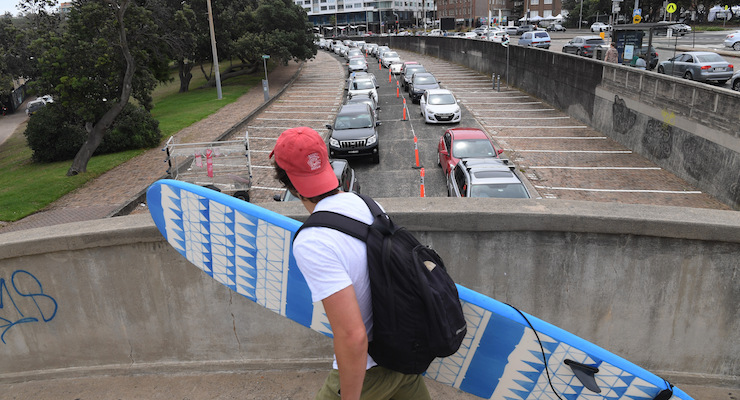
So here we go again. Just when Australians thought they could get a relatively normal Christmas, an outbreak of COVID-19 cases on Sydney’s northern beaches has led to border closures and a localised lockdown.
The state recorded 15 new cases in the 24 hours up to 8pm yesterday, from a record 38,000 tests. It was the lowest case figure since last Thursday.
On the weekend, Premier Gladys Berejiklian put the northern beaches into a five-day lockdown, with residents only allowed to leave home for essential reasons. And, with Sydney back on the “knife edge”, the state government has the unenviable task of trying to strike a balance on the eve of the holiday season. Lock down too hard, and you risk ruining Christmas. Don’t lock down enough, and you also run the risk of ruining Christmas.
So, is NSW moving quickly enough?
Too soon or too late?
So far, the NSW government seems to have learned from Melbourne and acted quicker than Victoria in responding to the latest outbreak.
The targeted lockdown for the beaches came into place on Saturday, just two days after the first cases of community transmission were detected in the area. There were 23 cases of community transmission recorded that day.
Melbourne, meanwhile, instituted a short-lived localised lockdown on June 30 — a day when 60 new cases were recorded, more than half of which were still under investigation (nearly all the cases in the beaches cluster have been traced so far). In the 10 days before that announcement, Victoria recorded a daily average of 39 cases, peaking at 75.
Those restrictions also came 10 days after Melbourne reintroduced restrictions on household gatherings, after widespread evidence of family-to-family transmission. In other words, things got worse for longer in Victoria before localised restrictions were introduced.
But NSW hasn’t moved as aggressively as South Australia did when faced with a cluster in November. On November 16, when 17 new cases were recorded in Adelaide, the state introduced tighter restrictions, including cancelling community sport and adding a 100 person cap at pubs and clubs. Two days later, the state announced a six-day hard lockdown, even though just two new cases were recorded, taking the Parafield cluster to 22 (the northern beaches cluster is currently at 83).
Then again, the SA lockdown was probably too over the top, especially given it was cancelled three days in, after it became clear a pizza shop worker had lied to contact tracers.
What about the masks?
The outbreak in Sydney has also led to increasing calls for more mask-wearing. The government has thus far stopped short of mandating masks, instead “strongly recommending” people wear them in indoor areas like public transport, supermarkets and healthcare facilities.
So far, some experts have urged the government to make mask-wearing compulsory, with the University of Melbourne’s Tony Blakely calling the lack of mandate “bonkers”.
But a mask mandate also creates the issue of enforcement — likely leading to more fines and policing. And importantly, Victoria was very slow to introduce compulsory mask laws. These were introduced by Premier Daniel Andrews on July 19, when Victoria had recorded 363 new cases, and after more than a week of stage-three restrictions.
Of course, masks could be mandated in coming days if things get worse. But thus far, the NSW approach of playing each day as it comes and letting the contact tracers hold the line has reined in bigger outbreaks than this one, and seems to be getting results so far.
There’s no reason that strategy won’t work again.








Maybe SA was over the top, but better to lockdown quickly and open up quickly, rather than give this virus a chance.
This article is very biased towards nsw, who seem to me to have been very lucky to date. Never mind that they spread the virus in the first place via Ruby Princess, no one accountable apparently, also Morrison being late closing borders to USA, and still managing to let people off international planes but somehow getting off scot free as the passengers were virus free. This new US strain has spread and will spread far and wide by entitled wealthy folk of the ‘northern beaches’, with wishy washy suggestions of mask wearing etc.
Andrews has made mistakes but has had the gumption to have an inquiry, not so nsw, and learnt from mistakes. However, none of them are learning to hold quarantined travellers outside cities, say in cabin parks or detention centres like Christmas Island.
Meanwhile the national government is disappeared by media while it’s abrogating its border and quarantine responsibilities, while this article seems to hold Victoria/SA responsible for how Covid is tackled or not; still? From the natonal government…. silence.
“But thus far, the NSW approach of … letting the contact tracers hold the line has reined in bigger outbreaks than this one” – although it did ‘rein’ it in very very slowly.
And hope there is no increased infection on the 25th and then an explosion on NYE.
The lack of mask mandates is political prevarication par excellence.
No leadership to be found here.
We will likely get away with it, because the people are taking it much more seriously than the govt.
And Morrison nowhere to be seen, and News Corpse silent.